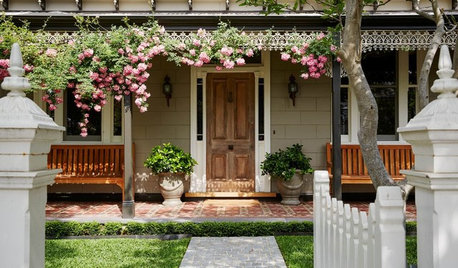What is the Lasagna method
chadnliz
18 years ago
Related Stories

GARDENING GUIDESGardening Solutions for Heavy Clay Soils
What’s a gardener to do with soil that’s easily compacted and has poor drainage? Find out here
Full Story
GREAT HOME PROJECTSHow to Replace Your Lawn With a Garden
New project for a new year: Lose the turfgrass for energy savings, wildlife friendliness and lower maintenance
Full Story
LANDSCAPE DESIGNFront-Yard Makeover Ideas With Mojo
Make a statement in your front landscape with one of these standout styles
Full Story
LAWN ALTERNATIVESStop Fighting the Patchy Lawn!
Here are 3 situations where a garden may be a better idea than more turfgrass
Full Story
SAVING WATERHouzz Call: Are You Letting Go of Your Lawn?
Many facing a drought are swapping turf for less thirsty plantings. If you’re one of them, we’d like to hear about it
Full Story
GARDENING GUIDESLush, Foodie Abundance in a Small Urban Garden
This modest backyard garden provides its owner with fruit and vegetables all year round, thanks to an innovative low-maintenance approach
Full Story
LANDSCAPE DESIGNGet Along With Less Lawn — Ideas to Save Water and Effort
Ditch the mower and lower your water bill while creating a feast for the eyes with diverse plantings and gathering places
Full Story
GARDENING GUIDESGet on a Composting Kick (Hello, Free Fertilizer!)
Quit shelling out for pricey substitutes that aren’t even as good. Here’s how to give your soil the best while lightening your trash load
Full Story
KITCHEN DESIGNA Cook’s 6 Tips for Buying Kitchen Appliances
An avid home chef answers tricky questions about choosing the right oven, stovetop, vent hood and more
Full Story
LIFEThe Moving-Day Survival Kit: Lifesaving Items and Niceties
Gather these must-haves in advance for a smooth move and more comfortable first days in your new home
Full StoryMore Discussions






username_5
meldy_nva
Related Professionals
Maple Valley Landscape Architects & Landscape Designers · Foothill Ranch Landscape Architects & Landscape Designers · Fort Payne Landscape Contractors · Lehigh Acres Landscape Contractors · Nashua Landscape Contractors · South Lake Tahoe Landscape Contractors · Webster Groves Landscape Contractors · Whittier Landscape Contractors · Camp Springs Landscape Contractors · Shenandoah Landscape Contractors · Suisun City Landscape Contractors · San Antonio Window Contractors · Bridgeport Window Contractors · Miami Springs Window Contractors · Revere Window Contractorspitimpinai
triple_b
meldy_nva
pitimpinai
meldy_nva
username_5
meldy_nva
anointedone435_gmail_com